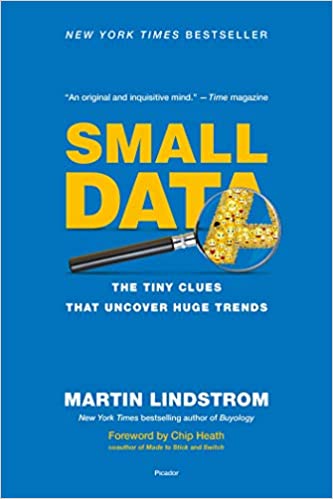Small data, well what is that? We all are done to death with marketing and hype of Big Data. Everywhere, data means Big data. Big consulting firms are selling solutions to mine and analyze big data as a silver bullet to all marketing problems and no one talks about tiny data anywhere. The online world is filled with millions of nice infographics on how much data is generated every second to stress the point!
Big data has got its own share of global hype by the IT and consulting industry, which mesmerizes everyone from a computer science graduate to a CEO. Though, we are yet to see any super success stories as a result of big data for any firm. Firms are investing a lot of money blindly and have no clue what they are getting out of it.
Martin Lindstrom, author of another best-seller “Buyology: Truth and Lies About Why We Buy and the New Science of Desire”, introduces the concept of small data, which is nothing new but the typical ethnographic research which is based on observations and interviews. Lindstrom does not downplay big data but cautions about too much reliance without any clear objectives. He has consulting experience with some of the world’s biggest firms. In this book, he exemplifies the importance of such observational data (tiny clues) which we rarely look at, and how such small clues can be used to solve complex real-world problems. Lindstrom shares some real-life consulting cases where he used these tiny clues to come up with answers. His writing style is engaging and fascinating. Once you start the book, it is very tough to put it down. Some of the compelling business problems discussed in the book are:
How a noise reduction headset at 35,000 feet led to the creation of Pepsi’s new trademarked signature sound.
- How a worn-down sneaker discovered in the home of an 11-year-old German boy led to LEGO’s incredible turnaround.
- How a magnet found on a fridge in Siberia resulted in a U.S. supermarket revolution.
- How a toy stuffed bear in a girl’s bedroom helped revolutionize a fashion retailer’s 1,000 stores in 20 different countries.
- How an ordinary bracelet helped Jenny Craig increase customer loyalty by 159% in less than a year.
- How the ergonomic layout of a car dashboard led to the redesign of the Roomba vacuum.
Though the book is not in league of psychology books such as Who Shapes our Choices and Decisions? Power of Social Influence or Misbehaving: The Making of Behavioral Economics, still anyone interested in data analytics, insights, and specially people overwhelmed by the hype if big data must read it. It can break the myths surrounding big data. The ethnographic research must get it due and there is nothing like seeing users how they use your products. In India, there are many success stories such as Gillete redesigned the shaver based on very different shaving habits and environment of Indian consumers. Similarly, Washing machines have changed the design and even detergent composition is changed to suit the typical requirements and water quality in India.
The below quote aptly summarizes the book.
If you want to understand how animals live, you don’t go to the zoo, you go to the jungle.
